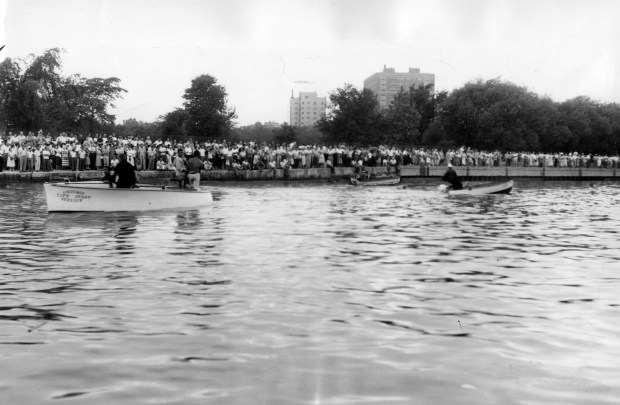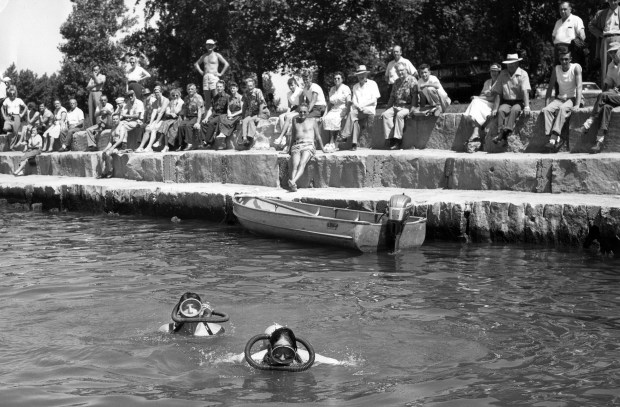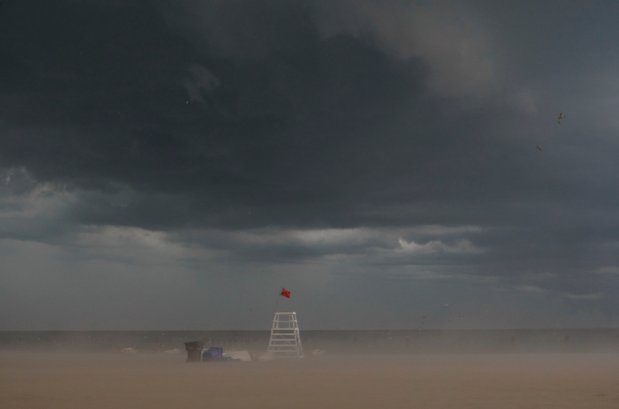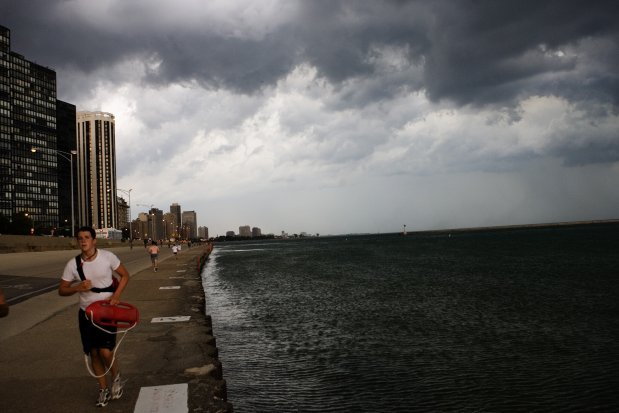[ad_1]
While Chicagoans sweat through a stretch of brutally hot days, those who lived here 70 years ago were shivering. The start of the city’s meteorological summer in 1954 was anything but summerlike, retired National Weather Service observer Frank Wachowski told the Tribune in 2006. High temperatures failed to get out of the 60s and overnight lows hovered near 50. But it was more than just cool. Rain fell on the first four days of the month, and sunshine was practically nonexistent as a heavy overcast dominated the skies.
Then in one of the most dramatic temperature reversals in Chicago’s history, everything changed. Summer heat roared into the city with a vengeance, and June 1954 went on to become one of Chicago’s hottest Junes on record. Seven high temperature records were set and one was tied that month as a searing heat wave gripped the city, producing a record-tying 11 straight days in the 90s.
Here are Chicago’s hottest days — with temperatures of 100 degrees or higher — on record
June 26, 1954, started out steamy and stormy. That morning, a thunderstorm started in LaCrosse, Wisconsin, and moved southeasterly including through Madison, Rockford and Milwaukee. At 7:30 a.m. it crossed over Chicago and blew out onto Lake Michigan at nearly 55 miles an hour, leading Joseph Pecararo to assume the worst of the day’s weather was over. The sky was clear and the lake was still by the time the 24-year-old lifeguard captain arrived for work at North Avenue Beach. With temperatures expected to climb to nearly 100, he expected a big Saturday crowd. But at that time the beach was deserted, except for a pair of fishermen out on the hook-shaped pier and a line of rowboats stored in front of the beach house, ready for use in an emergency.
At 8:10 a.m. the storm hit Michigan City, pushing a 5-foot wall of water over the breakwater and onto the shore. It then reflected back and began racing at nearly 55 miles per hour toward Chicago.
‘I thought the end of the world was coming’
Inhalator squads work on fisherman John Jaworski, 52, at North Avenue Beach after a huge wave hit the lakefront and killed eight people on June 26, 1954. Jaworski was swept off the pier and was one of the eight people killed.(Chicago Tribune historical photo)
A freakish, 10-foot-high inland wave crashed onto the Chicago shoreline from the Chicago River north to Wilmette at about 9:30 a.m., on June 26, 1954. A 1985 Tribune reconstruction described it as a “monstrous, hump-backed sea beast.”
The wall of water crashed over Pecararo and other lifeguards without warning, knocking them from their feet. When they surfaced, “we laughed, we thought it was kind of funny,” he recalled in 1994. “But seconds later a person came running over and said there was a fisherman swept off the pier.”
John Jaworski, fishing with his 18-year-old son Joseph, disappeared. Jaworski was just the first of the victims of the large wave, originally thought to be one of Lake Michigan’s most unusual phenomenon: a seiche (pronounced saysh). Such potentially deadly waves are formed when a squall line with high winds drives water across the lake, in the same way that blowing on a hot cup of coffee pushes the liquid toward the far rim. The winds then pass off the lake, but the water sloshes back across, producing damaging waves with no storm to warn of their impending arrival.
“We never saw anything like that,” Pecararo said. “I thought the end of the world was coming.”
Lifeguards from North Avenue Beach had just managed to recover Jaworski’s body in the rough water by forming a line and pushing it in toward the shore when a squad car rolled up with the news: “Dozens down at Montrose!”
“We jumped in the squad car. It was a wild ride,” Pecararo remembered.
‘When I looked back, I saw people being washed off the pier’
 The Coast Guard continued to search for bodies of victims of a giant wave that washed dozens of fishermen off the Montrose Harbor pier on June 26, 1954. Eight people were killed. (Al Phillips/Chicago American)
The Coast Guard continued to search for bodies of victims of a giant wave that washed dozens of fishermen off the Montrose Harbor pier on June 26, 1954. Eight people were killed. (Al Phillips/Chicago American)
The only warning Herbert Riederer, then a 24-year-old state conservation officer, had of the impending wave was a wet shoe. He’d just finished writing a ticket to a fisherman without a license when water suddenly rose onto the Montrose Harbor breakwater where he was standing. About 50 people at Montrose Harbor were caught on the breakwater.
“I stepped up to higher ground,” he remembers. “As I did, I heard a rush of water, and when I looked back, I saw people being washed off the pier.”
Riederer, who had no radio, raced for help to a nearby roadway, where he “commandeered the first car I saw and had him drive me to the bait shop” a half-mile away, where the nearest phone was located.
Mae Gabriel, 48, and her husband, Edward, 49, were later found drowned. The couple had planned to renew their marriage vows at their son’s upcoming wedding.
“It’s not something you can forget,” Riederer told the Tribune in 1994. “I can still see that woman, she was riding the crest of this huge wave into the harbor mouth, then she disappeared.”
Three bodies were pulled from the harbor that morning; four more were recovered later. One was Theodore Stempinski, the man Riederer had issued the ticket. Stempinski had apparently stopped to pick up his fishing gear before fleeing the pier.
Cause of death: ‘Act of God’
 Volunteer divers Robert Domkowski, left, and Chuck Napravnik, right, search Lake Michigan for three missing bodies at Montrose Harbor after a large wave hit the lakefront on June 26, 1954. Eight people died when the killer wave swept them off the lakefront. (Chicago Tribune historical photo)
Volunteer divers Robert Domkowski, left, and Chuck Napravnik, right, search Lake Michigan for three missing bodies at Montrose Harbor after a large wave hit the lakefront on June 26, 1954. Eight people died when the killer wave swept them off the lakefront. (Chicago Tribune historical photo)
It would take more than a week to find all the bodies. On July 8, 1954, a coroner’s jury officially listed the cause of death for the eight people: “… victims of a seiche caused by atmospheric conditions, otherwise an act of God.” Little did they know the cause of death would be revisited decades later.
Chicago Park District officials were confident at that point that all victims of the incident had been retrieved from Lake Michigan.
Predicting a ‘big wave’
 A dark sky looms over North Avenue Beach after the Chicago Park District issued a swim ban in response to a National Weather Service seiche warning on July 2, 2008. (Nuccio DiNuzzo/Chicago Tribune)
A dark sky looms over North Avenue Beach after the Chicago Park District issued a swim ban in response to a National Weather Service seiche warning on July 2, 2008. (Nuccio DiNuzzo/Chicago Tribune)
Small seiches occur on the lake all the time, but the magnitude of the one thought to have hit in June 1954 is rare. It triggered a flurry of scientific study into the phenomenon that quickly saved lives: Just weeks later, on July 6, 1954, a similar storm passed over Chicago, prompting the local weather service to issue a seiche warning.
Because of work done in the early 1960s by a University of Chicago team led by George Platzman of the Department of Geophysical Sciences, it is possible today to predict with a high degree of accuracy not only which storm systems will cause seiches but also where the seiche waves will hit the hardest, how big they will be and when they will arrive at the Chicago lakefront. The point is that if a seiche warning is in effect, one cannot rely on the surface condition of the lake to tell when the threat has passed.
Was the seiche really a meteotsunami?
 A lifeguard runs south down the lakefront bike path ready for a possible seiche as dark clouds move out over the lakefront at Chicago Avenue on July 2, 2008. A seiche alert closed the beaches. (Alex Garcia/Chicago Tribune)
A lifeguard runs south down the lakefront bike path ready for a possible seiche as dark clouds move out over the lakefront at Chicago Avenue on July 2, 2008. A seiche alert closed the beaches. (Alex Garcia/Chicago Tribune)
Scientists have now determined the north shore was struck in June 1954 by a meteorological tsunami (commonly called a meteotsunami) rather than by a seiche, as originally reported. Both are caused by spikes in air pressure and driving winds, which cause water to pile up as a storm moves across a lake. But they differ in size and time span. A seiche is a singular lakewide wave rocking back and forth while a meteotsunami is generally the width of a storm front and lasts for a shorter period of time.
Chicago’s predisposition to meteotsunamis stems from factors including the intensity, direction and speed of storms, in addition to the depth and shape of Lake Michigan. The shallow waters and prevalence of storms make it a “sweet spot” for meteotsunami activity.
“Southern Lake Michigan kind of has a natural setting where the speed (of a storm) needed to create a meteotsunami is possible and the shape of the lake points them toward Chicago,” said Adam Bechle, a coastal resilience outreach specialist for the University of Wisconsin Sea Grant Institute.
Did a shark attack occur in Lake Michigan? Here’s what Tribune reporters discovered in the 1970s.
Fast-moving storms capable of stirring up a meteotsunami move across Lake Michigan from west to east, guiding a wave toward western Michigan or northeast Indiana. When the storm passes onto land, the wave rocks against the shore and ricochets back toward Chicago.
“The risk of it impacting people goes up when it’s decoupled from the storm that made it,” Anderson said. “When a meteotsunami gets close, and it’s associated with lightning and a thunderstorm, people know to take certain precautions to protect themselves. When it pinballs back to the other side of the lake, it’s more hazardous because it could happen under sunny skies.”
That’s precisely what happened on June 26, 1954.
Meteotsunamis are “sort of the sharks of the Great Lakes,” Great Lakes Surf Rescue Project Director Dave Benjamin told the Tribune in 2019. “It gets national news, but there are only a small percentage of people affected.”
Want more vintage Chicago?
Become a Tribune subscriber: It’s just $12 for a 1-year digital subscription
Follow us on Instagram: @vintagetribune
Thanks for reading!
Join our Chicagoland history Facebook group and follow us on Instagram for more from Chicago’s past.
Have an idea for Vintage Chicago Tribune? Share it with Ron Grossman and Marianne Mather at rgrossman@chicagotribune.com and mmather@chicagotribune.com
Kori Rumore, Marianne Mather , 2024-06-20 21:00:37
Source link
[ad_2]



